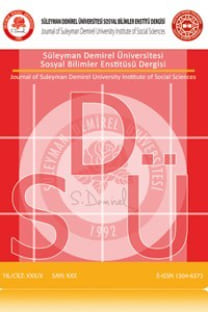EKONOMİK VE FİNANSAL ÜLKE RİSKLERİNİN PAY FİYATLARI OYNAKLIĞINA ETKİSİ
Borsalarda işlem gören pay senetleri, fiyatları ekonomik, finansal, politik, sosyal olmak üzere birçok nedenden dolayı oynaklıklar gösterebilmektedir. Pay fiyatlarında görülen oynaklıklar, paylarla ilgili risklerin var olduğunu göstermektedir. Pay piyasalarında meydana gelen bu oynaklıklar, pay senetleri yatırımcılarını, piyasalar arasındaki sermaye hareketliliğini, ulusal piyasalarını canlandırmak isteyen ekonomi yönetimlerini ve politika geliştiricileri yakından ilgilendirmektedir. Bu çalışmada, 1999-2016 dönemi ve 38 ülke örnekleminde pay senetleri fiyat oynaklıklarını etkileyen ekonomik ve finansal ülke risk faktörleri araştırılmıştır. Panel veri analizi yapılan çalışma sonuçlarına göre, borç servisi/ihracat, döviz kuru istikrarı ve dış borç/GSYİH değişkenlerinden oluşan finansal risk faktörleri ile enflasyon ve ekonomik büyümeden oluşan ekonomik risk faktörlerinin, pay fiyatları oynaklıklarını artırdığı görülmüştür.
Anahtar Kelimeler:
Oynaklık, Pay Senetleri, Ekonomik ve Finansal Riskler
THE EFFECT OF ECONOMIC AND FINANCIAL COUNTRY RISKS ON STOCK PRICES VOLATILITY
Stock prices which are quoted on stock exchanges may show volatility for many reasons including economic, financial, political and social reasons. The volatility in share prices indicates that there are risks related with shares. These volatilities in share markets are closely related to stock investors, capital mobility between the markets, policy makers and who want to improve their capital markets. In this study, 38 country samples were investigated between the period of 1999-2016, which economic and financial country risk factors affecting the stock price volatilities. According to the results of the panel data analysis, it was seen that financial risk factors consisting of debt service / export, exchange rate stability and external debt / GDP variables and economic risk factors consisting of inflation and economic growth increased the volatility of share prices.
Keywords:
Volatility, Shares, Economics and Financial Risks,
___
- BATTEN, J. A., CINER, C. and LUCEY, B. M. (2010). The Macroeconomic Determinants of Volatility in Precious Metals Markets, Resources Policy, 35(2). 65-71.
- BELTRATTI, A., and MORANA, C. (2006). Breaks and Persistency: Macroeconomic Causes of Stock Market Volatility, Journal of Econometrics. 131(1-2), 151-177.
- BOLLERSLEV, T., ENGLE, R. F. and NELSON, D. B. (1994). ARCH Models, Handbook of Econometrics. 4, 2959-3038.
- BROOKS, C. (2014). Introductory Econometrics for Finance, 3. Edition, Cambridge Press, U.K.
- CLARK, E. and KASSİMATİS, K. (2004). Country Financial Risk and Stock Market Performance: The Case of Latin America, Journal of Economics and Business. 56(1), 21-41.
- CORRADI, V., DISTASO, W. and MELE, A. (2013). Macroeconomic Determinants of Stock Volatility and Volatility Premiums. Journal of Monetary Economics. 60(2), 203-220.
- DIEBOLD, F. X. and YILMAZ, K. (2008). Macroeconomic Volatility and Stock Market Volatility, Worldwide (No. w14269). National Bureau of Economic Research.
- HANDAYANI, H., MUHARAM, H., MAWARIİ, W. and ROBİYANTO, R. (2018). Determinants of the Stock Price Volatility in the Indonesian Manufacturing Sector, International Research Journal of Busıness Studies. 11(3), 179-193.
- HASSAN, M. K., MARONEY, N. C., EL-SADY, H. M. and TELFAH, A. (2003). Country Risk and Stock Market Volatility, Predictability and Diversification in the Middle East and Africa, Economic Systems. 27(1), 63-82.
- KALOTYCHOU, E. and STAIKOURAS, S. K. (2010). An Overview of the Issue Surrounding Stock Market Volatility, Stock Market Volatility. (Edit. GREGORİOU, G. N.). CRC Press. U.K.
- KARA, E. and KARABIYIK, L. (2015). The Effect of Country Risk on Stock Prices: an Applıcatıon In Borsa Istanbul, Suleyman Demirel University Journal of Faculty of Economics & Administrative Sciences. 20(1), 225-239.
- KARALI, B. and RAMIREZ, O. A. (2014). Macro Determinants of Volatility and Volatility Spillover in Energy Markets, Energy Economics. 46, 413-421.
- LEHKONEN, H. and HEIMONEN, K. (2015). Democracy, Political Risks and Stock Market Performance, Journal of International Money and Finance. 59, 77-99.
- MUSHTAQ, R., ZIA UR REHMAN, M., ALI SHAH, S. Z. and MURTAZA, G. (2011). The Relationship between Stock Market Volatility and Macroeconomic Volatility: Evidence from Pakistan.
- OMOROKUNWA, O. G. and IKPONMWOSA, N. (2014). Macroeconomic Variables and Stock Price Volatility in Nigeria, Annals of the University of Petroşani. Economics. 14, 259-268.
- RABBANI, A. G., GRABLE, J. E., HEO, W., NOBRE, L. and KUZNIAK, S. (2017). Stock Market Volatility and Changes in Financial Risk Tolerance During the Great Recession, Journal of Financial Counseling and Planning. 28(1), 140-154.
- SADORSKY, P. (2003). The Macroeconomic Determinants of Technology Stock Price Volatility, Review of Financial Economics. 12(2), 191-205.
- SCHWERT, G. W. (1989). Why Does Stock Market Volatility Change Over Time?, The Journal of Finance. 44(5), 1115-1153.
- SOLAKOGLU, M. N., DEMIR, N. and ORHAN, M. (2009). Are Macroeconomic Variables Important for the Stock Market Volatility?, Evidence from the Istanbul Stock Exchange. (Edit. Gregoriou, G. N.). USA
- TASKIN, F. D. and KAPUCUGIL-IKIZ, A. (2013). The Determinants of Volatility of Market Price Returns of US Dollar and Euro Futures Contracts Traded in TurkDEX, Business Management Dynamics. 2(11), 20.
- ÜN, T. (2015). “Stata ile Panel Veri Analizi”, s. 40-79, Edit. GÜRİŞ, S. Stata ile Panel Veri Modelleri, Der Yayınları, İstanbul.
- YERDELEN TATOGLU, F. (2013). Panel Veri Ekonometrisi Stata Uygulamalı, Beta Yayıncılık, İstanbul.
- Yayın Aralığı: Yılda 3 Sayı
- Başlangıç: 2005
- Yayıncı: Süleyman Demirel Üniversitesi
Sayıdaki Diğer Makaleler
EKONOMİK VE FİNANSAL ÜLKE RİSKLERİNİN PAY FİYATLARI OYNAKLIĞINA ETKİSİ
OTİZMLİ ÇOCUĞU OLAN AİLELERİN SOSYAL DIŞLANMASINI ÖNLEYİCİ- BİR SOSYAL İÇERME ÖRNEĞİ
Hande KIRIŞIK, Nilüfer KORKMAZ YAYLAGÜL
SALGIN SÜRECİNDE YAŞLI NÜFUS, SOSYAL DIŞLANMA VE YAŞ AYRIMCILIĞI
ÖNLİSANS ÖĞRENCİLERİNİN SOSYO-DEMOGRAFİK ÖZELLİKLERİNE GÖRE BOŞ ZAMAN YÖNETİMİ
Ercan KÜÇÜKESMEN, Ali ŞİMŞEK, Mustafa Erhan TÜRKOĞLU
KAHİRE KONUŞMASINDAN OBAMA DOKTRİNİNE: TEK LİDER İKİ ORTADOĞU TEMSİLİ
